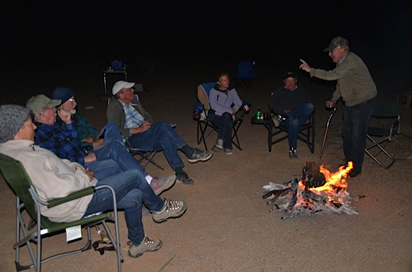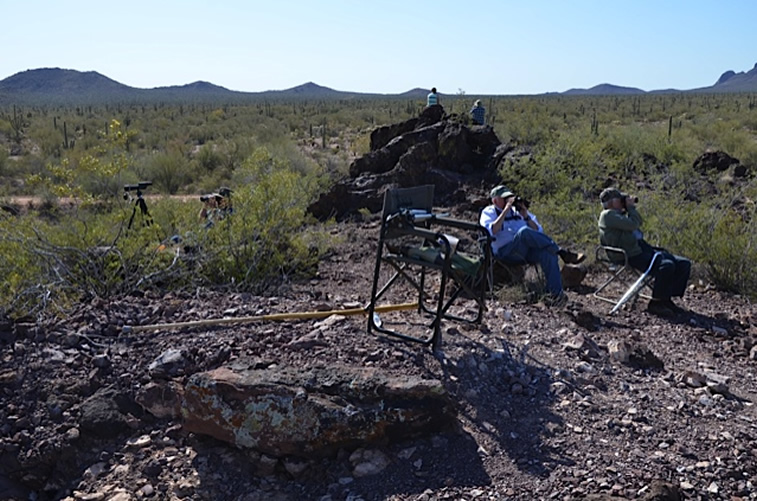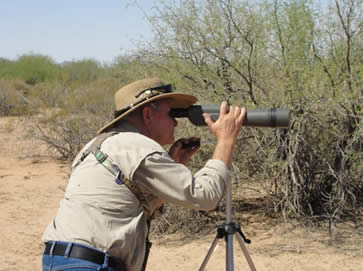 |
 |
|||||||||||||||||||||
|
||||||||||||||||||||||
AZFO FIELD EXPEDITION
Second Survey for Crested Caracara (Caracara cheriway) Nests
on Santa Cruz Flats, Pinal County
April 5, 2014
Doug Jenness
Rich Glinski
Introduction
 |
| Fig. 1. John Levy enriched discussion about caracaras at campfire. Photo/Rich Glinski |
Data collected over the past decade show that Crested Caracaras are increasingly utilizing the agricultural fields on the Santa Cruz Flats, particularly from November through March. A record high of 104, mostly subadults, was observed feeding together in a freshly disced cotton field on 24 January 2014. Seven other caracaras were found in other locations on the Santa Cruz Flats that same day. With these significant numbers in an extensive agricultural area (estimated 360 sq. mi.) bordered on at least two sides by native Palo Verde (Cercidium microphylla)-Saguaro (Carnegiea gigantea) habitat along with velvet mesquite (Prosopis velutina), the preferred nesting habitat of Crested Caracaras in Arizona, there is clearly a possibility of breeding. Adults have been reported feeding in cattle pastures through the breeding season, and there was an observation by D. Jenness in May 2010 of a caracara carrying food in its beak from the farm fields toward the saguaro habitat near the Silverbell Mountains. This reinforces the case for breeding caracaras in this area, which is 15 miles farther north than known current nest sites for this species. Following up on this evidence, the Arizona Field Ornithologists (AZFO) organized a survey on 23 March 2013 to look for nests (see report). None were found, but much information was gathered about other sites for setting up observation points to scan for nesting activity. In addition, since the 2013 survey, caracara nesting has been confirmed in the Three Points area of Altar Valley in 2007 and 2012-14 and on the east side of the Ironwood Forest National Monument near Marana in 2013. These findings created a basis for organizing a second survey.
 |
| Fig. 2. Observers scanning caracara nesting habitat at observation point east of Silverbell Mountains. Photo/Rich Glinski |
Methods
Twenty-one participants were organized into seven teams on 5 April 2014 to survey a more extensive area than the previous year. Ten of the volunteers camped out the night before on state trust land, which offered an excellent opportunity to discuss around a campfire the status and distribution of Crested Caracaras in Arizona, how to identify caracara nests, and the care that must be taken if nests were discovered. This discussion was enriched by the participation of John Levy, who, with his brother Seymour, discovered the first Crested Caracara nest in the state in 1960 and helped conduct surveys on the Tohono O'odham tribal lands during 1986-88 (Fig. 1). Other veteran field researchers also participated in the discussion. The following morning campers assembled with the other participants in Red Rock at 7:00 a.m. 5 April and conducted surveys between 7:45 a.m. and 1:40 p.m.
All but one team were stationed at observation points where they scanned suitable caracara nesting habitat (Fig. 2 & 3). This included flat areas bordering the southern and western slopes of Picacho Peak and bordering the northern slopes of the Silverbell Mountains. Each team had at least one spotting scope and all observers had binoculars. The teams had satellite maps and survey forms to record their data. The weather was clear and sunny with temperatures ranging from 53°F. in the morning to a high of 73°F in the afternoon. Southwesterly breezes rarely were stronger than 5 mph.
 |
| Fig. 3. Craig Anderson scanning southeast of Picacho Peak Photo/ Doug Jenness |
Results
One Crested Caracara nest was discovered and photographed in a large saguaro. Typical of caracara nests it was constructed of fine, dried, brittle twigs rather than thicker creosote bush (Larrea tridentata) or mesquite branches. The tops of the saguaro arms were coated with the tell-tale whitewash usually associated with caracara nests. The nesting materials were stacked 4-5 ft. tall between the lower swirl of saguaro arms, suggesting that the nest has been there for a few years. Caracaras typically use the same nests year after year and add to them each year. The bottom of the nest was 10-12 feet above the ground, which is in the expected range for Arizona. Observers reported at least four adult caracaras in the vicinity of the nest, one of which flew up from the center of the saguaro arms, the area of the nest. It wasn't clear whether egg-laying had begun or why so many caracaras were in the vicinity of the nest.
Two other teams reported seeing a total of three caracaras, two of them adults, in their observation areas. Two were flying, likely searching for food, and one was feeding on the ground at a remote cattle tank. When flushed, it soared very high, not a common behavior. In addition, three caracaras were seen in farm fields as observers were going or coming from their observation points.
In the habitat surveyed, observers reported many other active nests in saguaros, including Red-tailed Hawk (7), Common Raven (3), Great Horned Owl (2), and Western Screech-Owl (1). Many apparently unoccupied nests were also reported, including two constructed with thin sticks that may have been used by caracaras.
Several participants arrived early to the campsite on Friday afternoon and were able to check out cultivated fields along Baumgartner Rd. 0.3 miles west of Wheeler Rd. where the local farmer had thrown three carcasses in the field. As he worked the field on his tractor, 13 Crested Caracaras feasted on the fresh carrion disregarding the tractor and its dust. They were mostly subadults, although at least two were adults. This was a high number for April in the Santa Cruz Flats. Four Swainson's Hawks circled overhead. Volunteers also enjoyed other raptors and vultures during the survey Saturday, including Red-tailed Hawk (17), American Kestrel (3), Harris's Hawk (1), Cooper's Hawk (1), Turkey Vulture (16), and Black Vulture (8).
Discussion
When the Arizona Breeding Bird Atlas (2005) was published, there were only two documented reports of caracaras nesting away from the south-central part of the Tohono O'odham tribal lands in Pima County --one near Three Points in the Altar Valley (1964) and one at Olsen Wash about 12 miles north of Oracle Junction in Pinal County (1986-88). The recent reports of nesting in Altar Valley suggest that nesting may have been undetected or unreported from there since 1964. Seymour Levy, in an unpublished 1988 report prepared for the Arizona Game and Fish Department, postulated that the Altar Valley may be a location of caracara nesting. The report from the east side of the Silverbell Mountains in 2013 also shows that nesting was occurring farther north than had been known with the exception of the Olsen Wash nest. Interestingly two caracaras were seen along Hwy. 79 in March 2012 at Deepwell Ranch Road and a single adult was observed at Bogard Wash about 4.0 mi. north of Olsen Wash in October 2013. The discovery of a nest on the Santa Cruz Flats that appears to have been used for a few years is especially significant. It is farther north than the other recently confirmed locations and is in the area where the largest aggregates of wintering nonbreeding caracaras have been reported in the state.
Are there more nests in the Santa Cruz Flats area? Levy's field research determined that typically caracara nests in Arizona are 5-10 miles apart, although he reported one exception. If this pattern is followed on the Santa Cruz Flats, it is not likely that there are more than two or three nests there, unless the proximity to a consistent food source from the fields and pastures of this extensive agricultural area allows them to establish smaller nesting territories. Hopefully, further research will be organized with funding for radio telemetry and other methods that may be able to determine the answer to this question, along with other questions such as the location of roosts and the dispersal pattern of nonbreeding birds.
AZFO thanks all who participated and helped make this survey a success: Warren Adams, Craig Anderson, Hailey Babb, Lidija Baker, Mike Baker, Carol Beardmore, Conrad Behre, Rich Glinski, Jim Griffith, Mary Griffith, Tim Helentjaris, Eric Hough, Doug Jenness, Ariana LaPorte, Jim Levy, Rachel Livingston, Larry Norris, Lin Smith, Carl Tomoff, Marceline VandeWater, Brian Walsh.
|
©2010 |
HOME | | | REPORT SIGHTINGS | | | PHOTOS | | | BIRDING | | | JOURNAL | | | ABOUT US | | | CHECKLISTS | | | AZ BIRD COMMITTEE | | | EVENTS | | | LINKS |